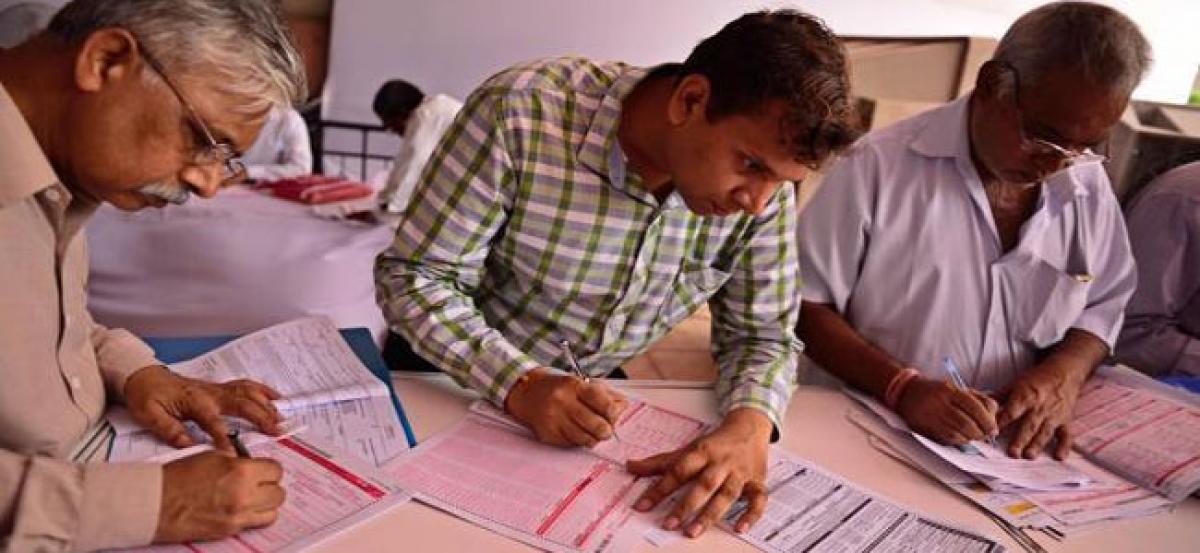Live
- First Impressions and Unboxing of the MacBook Pro M4: A Powerhouse for Professionals and Creators
- China Gears Up for Potential Trade War Amid Trump’s Tariff Threats
- Small Farmers Gain Less by Selling to Supermarkets: Study Reveals
- Why Despite the Controversy, America Is Anticipating the Mike Tyson vs. Jake Paul Fight
- Sanju Samson and Tilak Varma Shine: Record-Breaking Feats in 4th T20I Against South Africa
- India Urges $1.3 Trillion Annual Climate Support for Developing Nations
- Bad air: 106 shuttle buses, 60 extra Metro trips planned to make Delhiites give up cars
- WHO reports declining monkeypox cases in Congo
- CM Attends Kotideepotsavam on Kartika Purnima
- PKL Season 11: Raiding trio of Devank, Ayan, Sandeep help Patna Pirates rout Bengal Warriorz
Just In

The new Income Tax Return (ITR) forms for the assessment year 2018-19 were notified on Thursday by the Central Board of Direct Taxes (CBDT) that mandated salaried class assessees to provide their salary breakup and businessmen their GST number and turnover.
NEW DELHI: The new Income Tax Return (ITR) forms for the assessment year 2018-19 were notified on Thursday by the Central Board of Direct Taxes (CBDT) that mandated salaried class assessees to provide their salary breakup and businessmen their GST number and turnover.
HIGHLIGHTS
- The new ITR form mandates salaried class assessees to provide their salary breakup and businessmen their GST number and turnover
- All the seven ITRs are to be filed electronically except for some category of taxpayers
- The last date for filing the ITR is July 31
The policy-making body of the tax department said some fields have been "rationalised" in the latest forms and that there is no change in the manner of filing the ITRs as compared to last year.
All the seven ITRs are to be filed electronically except for some category of taxpayers, the CBDT said in a statement.
The most basic -- ITR-1 or Sahaj -- is to be filled by the salaried class of taxpayers, which was used by 3 crore taxpayers during the last financial year.The form this time seeks an assessees salary details in separate fields and in a breakup format such as allowances that are not exempt, value of perquisites, profit in lieu of salary and deductions claimed under section 16.
These details are provided in the Form 16 of a salaried employee and a senior tax official said that these are now meant to be mentioned in the ITR for clarity of deductions.
The CBDT said the ITR-1 can be filed by an individual who "is resident other than not ordinarily resident and having income of up to Rs 50 lakh and who is receiving income from salary, one house property or other interest income".
"Further, the parts relating to salary and house property have been rationalised and furnishing of basic details of salary (as available in Form 16) and income from house property have been mandated," CBDT spokesperson Surabhi Ahluwalia said.
The ITR-2 has "also been rationalised" for individuals and HUFs (Hindu Undivided Families) having income under any head other than business or profession."The individuals and HUFs having income under the head business or profession shall file either ITR-3 or ITR-4 in presumptive income cases," the statement said.
Under the ITR-4, assessees who have presumptive income from business and profession will have to furnish their GST registration number and its turnover.In case of non-resident taxpayers, the requirement of furnishing details of "any one" foreign bank account has been continued like the last time for the purpose of credit of refund, it said.
Further, the statement said, the requirement of furnishing details of cash deposit made during a specified period (in the wake of the note ban of 2016) as provided in ITR form for the Assessment Year 2017-18 has been "done away with" this time.
Space has also been provided in forms to either mention the 12-digit Aadhaar number or the 28-digit enrolment Aadhaar ID, as was the case in last years' forms.
The CBDT said that individual taxpayers of 80 years or more at any time during the previous year or an individual or HUF whose income does not exceed Rs 5 lakh and who has not claimed any refund, can file ITR in the paper form, using the ITR-1 or ITR-4.
The new ITRs have been uploaded on the official website of the department--www.incometaxindia.gov.in.The last date for filing the ITR is July 31.

© 2024 Hyderabad Media House Limited/The Hans India. All rights reserved. Powered by hocalwire.com







